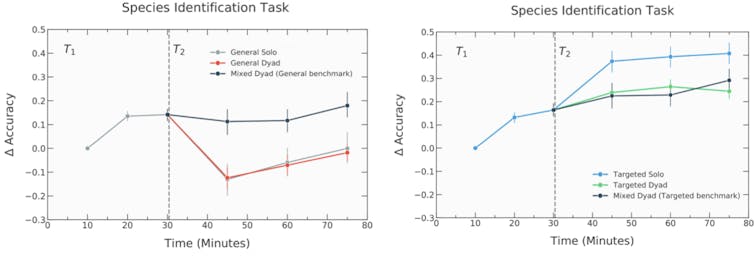Opinion: Teamwork is not always the best way of working, new study
Posted 21 August, 2023

(opens in a new window)Girts Ragelis/Shutterstock
Throughout the 21st century, teamwork has come to (opens in a new window)define the modern work environment. Driven by advances in communication technology, working collaboratively is, as management experts will tell you, how you harness the “(opens in a new window)collective intelligence”.
Collective intelligence (opens in a new window)is often seen as greater than the sum of its parts: superior to the cumulative individual intelligence of the group’s members. Capitalising on it (opens in a new window)is said to improve task accuracy (finding better and more correct answers), and enhance task efficiency (finding good answers faster). This in turn leads to quicker and higher quality completion. In other words, when we work together, our performance improves. This has been one of the major factors shaping our modern societies.
At the same time, though, both (opens in a new window)research and popular idiom underline the limits inherent to the concept. If “two heads are better than one” suggests the benefits of collaboration, “too many cooks spoil the broth” suggests the opposite.
I led a (opens in a new window)recent study looking at whether training and team composition might affect how efficient people are when working together. We found that the benefits of collective intelligence can be outweighed by the cost of having to coordinate between team members.

People are better able to learn from one another – and communicate – in person. (opens in a new window)Fizkes/Shutterstock
The dynamics of teamwork
We designed an experimental study using an existing online citizen science project, (opens in a new window)Wildcam Gorongosa. Participants analyse webcam photos taken in Gorongosa National Park, Mozambique, to find and identify animal species and behaviour.
We invited 195 members of the public to our lab in Oxford to participate. The experiment comprised two stages: training, then testing, which they did first on their own and then in teams of two. They had five subtasks to complete: detecting the presence of animals; counting how many there were; identifying what they were doing (standing, resting, moving, eating or interacting); specifying whether any young were present; and identifying the animals from 52 possible species (the option of “nothing here” was included, but not “I don’t know”).
We split the participants into two groups. One received targeted training with images similar to the test set. The other received general training with a diverse range of images.
We found the type of training did indeed affect their performance. For those with general training – the “generalists” – efficiency initially improved, but then declined, once they were tested on the specific set of test images. By contrast, those with targeted training – the “experts” – consistently maintained or improved their performance.
How performance changed during the training and testing stages:

To investigate the impact team dynamics would have, we then formed three types of group: these featured either two experts, two generalists, or a mixed pair.
Surprisingly, we found that neither two generalists nor a mixed group performed better than a single generalist working alone. Even two experts working together did not do better than a single expert.
How the groups’ composition affected their efficiency:

We also found that while having an expert in a group improved accuracy for the more complex tasks, it did not improve the group’s efficiency. In other words, the team got more correct answers but took considerably longer to do so. And for simple tasks, there was no improvement in accuracy from having an expert. Ultimately, the time that team members lost in coordinating with each other outweighed the benefit of adding an expert to the group.
What can we say about the future of work?
Research has long shown that underperformance in a group is often due to what social psychologists term “(opens in a new window)process losses”. The collective intelligence of a team can, for example, be (opens in a new window)adversely affected by social biases and what cognitive scientists call “herding” effects, because these can lead to collective decisions being disproportionately influenced by a few members of the group who are less competent yet more confident.
Further, psychologists speak about “(opens in a new window)social loafing” to describe a person performing poorly because they are part of a group – they have the impression that others will do the job without them needing to contribute. When a large number of team members follow this strategy, it can result in the combined efforts of the team being even lower than the sum of individual efforts.
Research also shows the importance of (opens in a new window)social learning in the context of effective collaborative working, which our study highlights. The experimental method we implemented involved individual training sessions followed immediately by testing the teamwork – this precluded opportunities for people to learn by observing their coworkers’ performance, and therefore one of the advantages of being part of the group during the learning process was eliminated.
The context in which teamwork and collaboration take place matters, as do the tools available for coordination between team members. As internet-based communication technologies are used not only for large-scale voluntary collaborative endeavours, such as citizen science projects, but also for remote working, it is important to recognise the potential effects of different training approaches and team dynamics.
When team members don’t have the chance to observe other workers and reap the advantages of social learning, and when communication is less efficient than face-to-face interactions, the costs and benefits in the teamwork equation can shift. Our research shows that this is even more pronounced when you’re dealing with simpler tasks that don’t require extensive creative problem-solving. Opting to work individually could indeed be a more viable approach.
The dynamics of teamwork – whether in the workplace or in the context of collective action – are complex. While collaboration offers benefits in specific contexts, it is essential to consider the trade-offs between time, accuracy and efficiency. Coordination comes (opens in a new window)at a cost.
By (opens in a new window)Taha Yasseri, Associate Professor, School of Sociology; Geary Fellow, Geary Institute for Public Policy, (opens in a new window)University College Dublin
This article is republished from (opens in a new window)The Conversation under a Creative Commons license. Read the (opens in a new window)original article.






